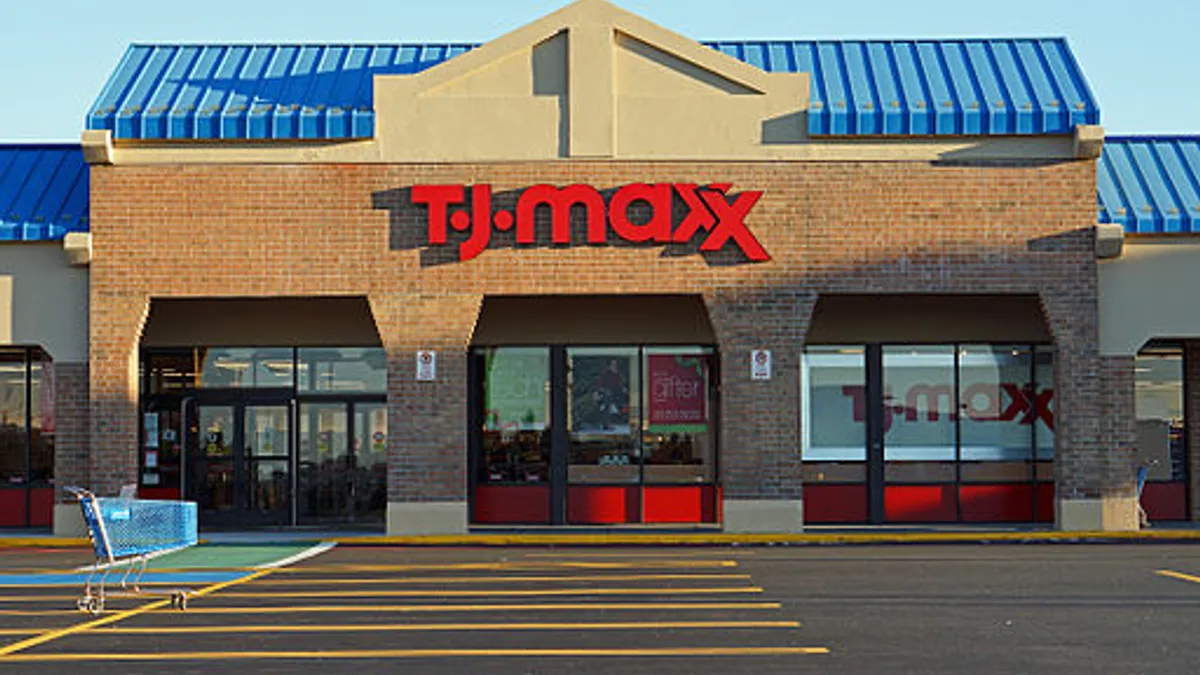The COVID-19 pandemic is smacking off-price retailers TJX Cos., (whose primary banners are Marshalls, TJ Maxx and HomeGoods), and Ross Stores (which runs Ross Dress for Less and dd's DISCOUNTS) in what is normally a strength: inventory.
The two reported results this week that revealed how inventory snafus and a dearth of e-commerce — the latter by choice — combined to tamp down sales even as stores reopened.
The pipeline of cast-off goods from department stores and specialty retailers has been undermined by supply chain issues and those retailers' own inventory troubles. As Ross stores reopened, for example, a pile-up of goods was enthusiastically snapped up by returning customers, but not easily replaced, according to Ross CEO Barbara Rentler.
TJX Cos.
| Q2 | $ | YoY |
|---|---|---|
| Net sales | $6.7 billion | -32% |
| Store comps | - | -3% |
| Net income (loss) | ($214 million) | -128% |
| Inventory | $3.7 billion | -26% |
Source: TJX press release *"Store comps" reports the sales increase or decrease for the days stores were open in the current period against sales for the same days in the prior year.
Ross Stores
| Q2 | $ | YoY |
|---|---|---|
| Net sales | $2.7 billion | -33% |
| Store comps | - | -12% |
| Net income (loss) | $22 million | -95% |
| Inventory | $1.1 billion | -39% |
Source: Ross press release *Comparable store sales reported from the date of reopening to the end of the fiscal quarter.
"During the initial re-openings, sales were ahead of our conservative plans as we benefitted from pent-up demand and aggressive markdowns to clear aged inventory," she said in a statement. "In the weeks thereafter, trends were negatively impacted from depleted store inventory levels while we were ramping up our buying and distribution capabilities."
In its release, TJX said it had planned lower store inventory levels in the quarter "primarily to promote social distancing for Associates and customers." That, plus stronger-than-expected sales as stores reopened, combined to create "supply chain and logistics challenges." But the company seems undaunted, also saying that overall "product availability in the marketplace remains excellent." As a result, TJX said it "has significantly increased its buying since the middle of July to support inventory flow" and is "flexing its buying towards the categories that have had the strongest demand upon reopening."
Indeed, that's pretty much all it will take, according to several analysts.
"Both companies presented a host of reasons for the lack of inventory; however, as we have been discussing throughout the pandemic ... our vendor checks were clear that when retailers stopped ordering, they stopped producing," BMO Capital Markets' Simeon Siegel said in emailed comments. "We expect lean inventory across the channel in [the second half of the year] but a return to long-term share gains for TJX and [Ross] amid department store dislocation over the long term."
While off-price retailers are best known for their apparel assortments, home goods emerged as a key category in the quarter. Ross and TJX offer more of that merchandise compared to off-pricers Burlington and Nordstrom Rack. But TJX in particular (which after all runs a global business dedicated to it, where sales in the quarter rose 20%) stands to benefit the most as consumers fix up their homes, according to MKM Partners Managing Director Roxanne Meyer, who called TJX "uniquely positioned" against its rivals.
"We believe that as consumers spend more time at home/working from home, and in migrating from cities to larger spaces in the suburbs, it is fueling strong demand for home furnishings, which has the potential to gain momentum from here before stabilizing," Meyer said in emailed comments. "The home category represents approximately one-third of TJX sales (more than at [Burlington and Ross]), though in 2Q likely surpassed 40% and has the potential to gain share over time given plans to grow HomeGoods/HomeSense and given category expansion."
Off-price retailers' emphasis on in-store treasure hunting, usually a strength, also continues to be disrupted by the pandemic. Wedbush analysts noted that Ross sales "continue to lag in states that have been heavily impacted by COVID-19, notably California, Florida, Texas, and Arizona, which also represents about 50% of the store base."
Similarly, TJX's "sales decline was mainly due to stores being open for only a little more than two-thirds of the quarter. The company [experienced] stronger than anticipated demand across the board initially after reopening, then moderated as the quarter moved on," the Wedbush team led by Jen Redding said in a separate note. Overall though, despite the dependence on stores, off-price remains among the strongest sectors in retail, and that includes its inventory advantages, according to Wedbush.
"Over the longer-term, we are confident that the Off-Price retailers will emerge as retail's winners in the post-COVID-19 era," Redding said. "As worldwide economies recover from the recessions and consumers cut budgets on discretionary spending, off-price traditionally turn towards discount stores. As disruptions in retail supply chains shake the majority of retailers, we're confident Off-Price can execute on strategies designed to take advantage of surplus inventories and capitalize on the disturbances."













